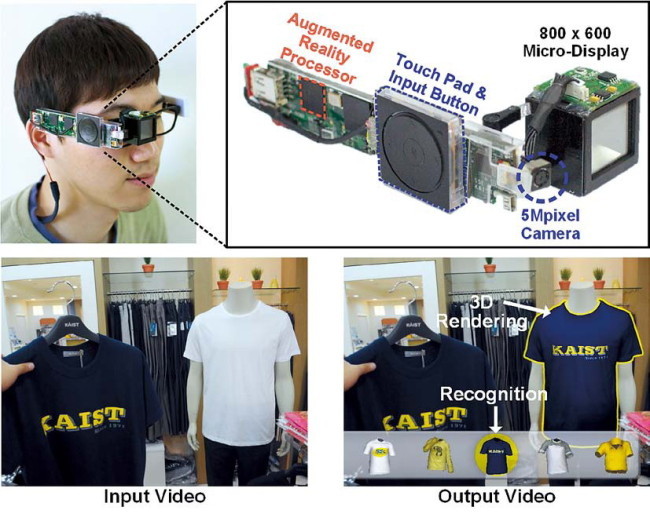현재 구글 글래스는 TI의 스마트폰용 AP를 사용하기 때문에 증강현실을 구현할 경우 화면이 끊기는 현상이 있다. 그래서 증강현실의 가장 낮은 단계인 바코드를 인식해서 2D 이미지를 띄어주는 정도만 가능하다. 그 다음 단계는 바코드가 없는 2D 이미지를 인식해서 3D로 정보를 띄어주는 것이다.
하지만 내년 초에 출시 예정인 케이 글래스는 자체 개발한 증강현실 전용 프로세서로 3D 물체나 환경을 인식해서 3D 이미지로 정보를 보여주는 것이 가능하다. 케이 글래스를 주도적으로 개발한 김경훈 연구원은 “예를 들어 사용자가 건물 안으로 들어가면 안경이 자동적으로 모든 화면을 포착하고 저장해서 파편화된 이미지들을 모아 하나의 입체적인 3D 이미지로 보여줄 수 있다”고 말했다.
다른 기술과의 연동도 가능하다. 사람의 얼굴을 인식해서 심박, 맥박을 보여주는 기술과 연동하면, 경기 중인 운동선수의 건강 정보를 알 수 있다.
증강현실 전용 프로세서를 사용하면 구글 글래스보다 30배 속도가 빠르고 전력효율이 10배 높아진다. 대신 이메일이나 유튜브 같은 스마트폰 기능을 사용할 때는 삼성이 개발한 엑시노스가 사용된다.
유교수는 우리나라 증강현실의 미래에 대해서 “경쟁력 있는 반도체 산업과 소프트웨어 산업이 협력해서 맞춰 나가면 세계 시장을 리드할 수 있을 것”이라고 말했다. 한국무역협회에 따르면 전세계 증강현실 규모는 2020년 420조원 규모로 증가할 전망이다.
<관련 영문기사>K-Glass to be unveiled in 2015
K-Glass, an electronic eyewear device developed by a team of South Korean researchers, is expected to be launched early next year, according to industry experts familiar with the matter.
“We plan to commercialize K-Glass in a small quantity late this year or early next year,” said Yoo Hoi-jun, a professor at South Korea’s Korea Advanced Institute of Science and Technology University, in an interview with The Korea Herald.
KAIST introduces the K-Glass, embedded with augmented reality technology. (KAIST)
K-Glass shares many similarities with Google Glass. Using the Android operating system, it enables users to surf the Internet, watch YouTube videos, check their email and take pictures. However, what makes K-Glass different from Google Glass is its focus on augmented reality experiences.
“Google Glass was originally developed to perform smartphone-like functions. What we wanted to do with K-Glass was to make the device capable of fully providing augmented reality experiences,” Yoo said.
He stressed that when smart glasses start to replace smartphones, augmented reality will become a key function. Worldwide, the augmented reality industry is expected to reach $380 billion by 2020, according to the Korea International Trade Association.
Augmented reality involves modifying users’ view of reality ― usually through computer-generated input such as sound, video, graphics or GPS data ― to enhance their perception of reality. Such enhancements can be viewed via the K-Glass eyepieces.
Currently, Google Glass provides only a minimum level of augmented reality experiences, such as by recognizing the barcodes of products and displaying the related information in 2-D.
The level of augmented reality that K-Glass can provide will be much more advanced, Yoo said.
“The device will recognize 3-D products and information in 3-D. For instance, when you walk into a building, the eyewear catches and collects all the information you see to display collective, 3-D images,” the professor said.
K-Glass can also be integrated with other technologies.
“For instance, there are technologies that tap into health conditions … (by monitoring) pulse or heart rates, and this is done by recognizing the face of the user. When K-Glass is integrated with this type of technology, we will be able to scan the health conditions of athletes playing in stadiums or other public venues,” said Kim Gyeong-hoon, a Ph.D. student at KAIST who has been involved in the K-Glass project.
This is possible thanks to an exclusive application processor for augmented reality that was developed by KAIST. This processor makes the K-Glass 30 times faster and consumes up to 10 times less energy than Google Glass, which uses Texas Instruments’ application smartphone processor.
By Shin Ji-hye (
shinjh@heraldcorp.com)








